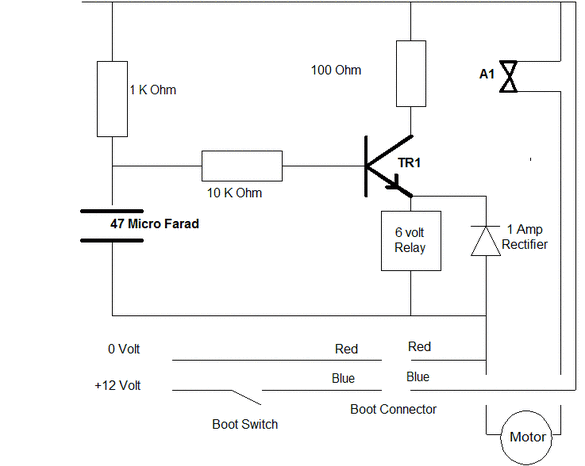TVR Griffith
This information has been gathered from personal experience and is believed to be accurate but there is no guarantee that this is the case. Anyone using this information does so on the understanding that its use is completely at their own risk and that no liability for errors or omissions or consequential damage to persons or possessions will be accepted by the author or his agents. Prospective users should make their own considered judgement or seek specialist advice as to the accuracy or otherwise of any statements made before using this information in anyway.
Boot Lid Motor Failure
The boot lid is released from a momentary action dash panel push button. Unfortunately this push button frequently sticks behind the dash causing the actuating motor to run continuously. As the motor is only light duty it burns out very quickly. The solution was to knock up a simple pulsed time delay unit that produces a single 1/2 second pulse when the button is pressed. After the single pulse, the supply is cut off so even if the button sticks all day no harm will result. The unit is placed between the existing boot connectors for the boot motor. Action: When the boot open button on the dash is pressed, +12 volts is fed to the circuit. The normally closed relay contacts A1 then route the +12 volts to the motor and the boot opens. After about 1/2 second the 47 micro-farad capacitor charges up sufficiently to cause the transistor TR1 to conduct, this operates the relay causing contacts A1 to open and the boot motor to stop running. Even if the push button sticks in the relay contacts remain open so no further current can reach the motor. There is a small current drain through the relay coil but this is only milliamps so of no consequence. I used a 2N3053 transistor but any NPN transistor of a similar rating would be OK. The device has been in place now for several years and to date no more burnt-out motors.
Supplier for components: Maplin
This information has been gathered from personal experience and is believed to be accurate but there is no guarantee that this is the case. Anyone using this information does so on the understanding that its use is completely at their own risk and that no liability for errors or omissions or consequential damage to persons or possessions will be accepted by the author or his agents. Prospective users should make their own considered judgement or seek specialist advice as to the accuracy or otherwise of any statements made before using this information in anyway.
Boot Lid Motor Failure
The boot lid is released from a momentary action dash panel push button. Unfortunately this push button frequently sticks behind the dash causing the actuating motor to run continuously. As the motor is only light duty it burns out very quickly. The solution was to knock up a simple pulsed time delay unit that produces a single 1/2 second pulse when the button is pressed. After the single pulse, the supply is cut off so even if the button sticks all day no harm will result. The unit is placed between the existing boot connectors for the boot motor. Action: When the boot open button on the dash is pressed, +12 volts is fed to the circuit. The normally closed relay contacts A1 then route the +12 volts to the motor and the boot opens. After about 1/2 second the 47 micro-farad capacitor charges up sufficiently to cause the transistor TR1 to conduct, this operates the relay causing contacts A1 to open and the boot motor to stop running. Even if the push button sticks in the relay contacts remain open so no further current can reach the motor. There is a small current drain through the relay coil but this is only milliamps so of no consequence. I used a 2N3053 transistor but any NPN transistor of a similar rating would be OK. The device has been in place now for several years and to date no more burnt-out motors.
Supplier for components: Maplin
